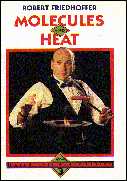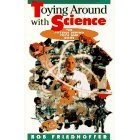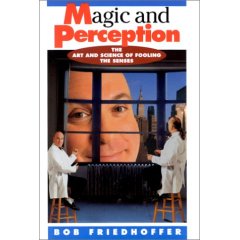|
www.sciencetrix.com |
THE SCIENTIFIC MAGIC SHOW
MAGIC TRICKS - SCIENCE FACTS |
| Home | Academic Video | Performance Video | Contact | About Us |
*PROGRAM INFORMATION* *LETTERS OF RECOMMENDATION* BOOK REVIEWS *ARTICLES* A REVIEW OF HISTORICAL LITERATURE WHY INFORMAL SCIENCE EDUCATION ? NY TIMES STORY re: An Elegant Solution
*SCIENCE AND MATH TRICKS* *VIDEO LINKS**CONTACT*
|
BOB FRIEDHOFFER
BOOK REVIEWS Light. (Illus.; from the Scientific Magic Series.) NY: Molecules and Heat. 92-16960. ISBN 0-5311 1053-2. EI - JH
Both of these books are well suited to elementary school students as young as third grade (if used as a guide to interesting classroom activities or for advanced readers) and would be appealing and useful up through junior high school. Both are excellent in that they are not stuffy and they try to engage the student via experiments and magic tricks using common household items. Friedhoffer manages to approach difficult subjects with humor. There is a great deal of healthy irreverence contained in his discussions of most topics. Nevertheless, he pays equal attention to the scientific concepts behind the magic tricks and constantly invites students to make their own observations. His experiments are written to engage young people in the spirit of scientific inquiry, at the same time providing them with means t entertain their friends and families. He provides warnings to ask for adult supervision for experiments that require potentially hazardous materials or activities (e.g., open flames). These books would make excellent classroom supplements, with teachers picking and choosing experiments and tricks to illustrate specific concepts. At times the flow of the text is unclear, and young people attempting to read the material on their own may end up with a collection of facts without a framework to hold them. Nevertheless, these volumes are intended as activity books, and the hands-on learning of both scientific ideas and scientific methods far outweighs any theoretical shortcomings they might have. I would recommend the series highly. Michael J. Sarette, United Technologies, BOOK REVIEWS
FRIEDHOFFER, ROBERT Toying Around with Science: The Physics Behind Toys and Gags. (Illus. by Linda Eisenberg.) NY: Walls, 1995. 95pp. $19.90. 94-49444. ISBN O-531-112152- Glossary; Indcx; C.I.P. This little book would make quite a nice gift for a child, particularly for one curious about how things work The author admits to taking things apart when be was 9 or 10 years old to see bow they worked. I wonder bow many of today's scientists had that same curiosity as children. I did, and at an even younger age, on some quite expensive toys that were not built to be taken apart! The toys described in this book are selected because they were inexpensive and available to all. The book's value lies in the way it uses toys to illustrate the application of the basic laws of physics-those governing pressure magnetism, friction inertia linear and angular momentum, gyroscopic motion, sound and vibration, levers and mechanical advantage, and kinetic and potential energy. The 10-page "Review of Scientific principles" and the glossary, both al the end of e book, are highly valuable. The child who reads these two sections thoughtfully will be well prepared for high school physics, both in vocabulary and in the scientific practiced of using a few basic principles to explain a variety of phenomena. William A. Kemper, Metropolitan State College, Denver, CO
Booklist
Friedhoffer, Bob. Magic and Perception: The Art and Science of Fooling the Senses. 1996. 109p. index. illus. Watts, lib. ea., $18.95 (0-531-11254-3). DDC: 793.8.Gr. 5-7. Friedhoffer, the author of Magic Tricks, Science Facts (1990), not only shows and tells how to perform magic tricks, he discusses how magicians are able to alter an audience's perceptions of what is taking place. Many clear line drawings and a few not-so-clear photographs illustrate the text. Students of magic may choose this book because of the author's thorough, practical approach to learning new tricks, but they'll also come away with a better overall understanding of the human senses and the physical and mental foibles that make illusions convincing. Appended resource lists include books, equipment suppliers, magazines, and organizations for magicians. A unique take on a popular topic. Carolyn Phelan information@sciencetrix.com rfriedhoffer@gc.cuny.edu rfriedhoffer@gc.cuny.edu information@sciencetrix.com |
|
|
Home l Contact l About Us |
||
|
Copyright Bob Friedhoffer 2007 - All Rights Reserved. |
||


